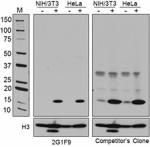- Clone
- 2G1F9 (See other available formats)
- Regulatory Status
- RUO
- Isotype
- Rat IgG2a, κ
- Ave. Rating
- Submit a Review
- Product Citations
- publications

-

Untreated (panel A) and sodium butyrate-treated (5 mM for 16 hours, panel B) HeLa cells were fixed with 4% paraformaldehyde for 10 minutes, permeabilized with 0.5% Triton X-100 for 10 minutes, and blocked with 5% FBS for 60 minutes. Cells were then intracellularly stained with a 2.5 µg/mL (1:100 dilution) of Alexa Fluor® 594 anti-Histone H3 Acetylated Lysine 9 (K9ac) (clone 2G1F9) overnight at 4°C. Nuclei were counterstained with DAPI, and the image was captured with a 60X objective.
Histone subunit H3, along with subunits 2A, 2B, and 4, make up the core subunits of the nucleosome octomer. An octomer contains two protomers of each subunit tightly wrapped around a ~147 bp segment of DNA. Histones have integral roles in chromatin integrity, genomic stability, and gene regulation. Post-translational modification of histones in response to certain stimuli results in alterations of nucleosomal positioning relative to DNA.
Product DetailsProduct Details
- Verified Reactivity
- Human, Mouse
- Antibody Type
- Monoclonal
- Host Species
- Rat
- Immunogen
- Histone H3 K9ac peptide
- Formulation
- Phosphate-buffered solution, pH 7.2, containing 0.09% sodium azide.
- Preparation
- The antibody was purified by affinity chromatography and conjugated with Alexa Fluor® 594 under optimal conditions.
- Concentration
- 0.5 mg/mL
- Storage & Handling
- The antibody solution should be stored undiluted between 2°C and 8°C, and protected from prolonged exposure to light. Do not freeze.
- Application
-
ICC - Quality tested
- Recommended Usage
-
Each lot of this antibody is quality control tested by immunocytochemistry. For immunocytochemistry, a concentration range of 1 - 5 μg/ml is recommended. It is recommended that the reagent be titrated for optimal performance for each application.
* Alexa Fluor® 594 has an excitation maximum of 590 nm, and a maximum emission of 617 nm.
Alexa Fluor® and Pacific Blue™ are trademarks of Life Technologies Corporation.
View full statement regarding label licenses - Application Notes
-
This clone is not recommended for ChIP (Chromatin Immunoprecipitation) assays (as determined by in-house testing).
- RRID
-
AB_2820118 (BioLegend Cat. No. 698403)
Antigen Details
- Structure
- Histone H3 is a 134 aa protein with a predicted molecular weight of 15.4 kD. The subunit is comprised of a histone fold, an αN-helix main globular domain and a large N-terminal tail harboring residues subject to multiple types of post-translational.
- Distribution
-
Nucleus
- Function
- Histone acetylation is generally associated with activation of gene expression, nucleosomal redistribution, and histone deposition. One consequence of this modification is the alteration of chromatin structure to facilitate recruitment of transcription factors. Additionally, acetyl-lysine modification is also used as binding site for proteins containing bromodomains, resulting in their recruitment to the modified histones.
- Interaction
- Histones 2A, 2B, 4, HDAC
- Biology Area
- Cell Biology, Chromatin Remodeling/Epigenetics
- Antigen References
-
1. Zhang, et al. 2017. Nat. Commun. 8: 14799.
2. Kanda M, et al. 2016. Proc. Natl. Acad. Sci. USA 113: E3394.
3. Bellet MM, et al. 2013. Proc. Natl. Acad. Sci. USA 9: 3333.
4. Li B, et al. 2016. Sci. Rep. 6: 26542.
5. Li D, et al. 2014, Mol. Cancer. 13:26. - Gene ID
- 8350 View all products for this Gene ID
- UniProt
- View information about Histone on UniProt.org
Related Pages & Pathways
Pages
Related FAQs
Other Formats
View All Histone Reagents Request Custom Conjugation| Description | Clone | Applications |
|---|---|---|
| Purified anti-Histone H3 Acetylated Lysine 9 (K9ac) | 2G1F9 | WB,ICC |
| Alexa Fluor® 594 anti-Histone H3 Acetylated Lysine 9 (K9ac) | 2G1F9 | ICC |
| Alexa Fluor® 488 anti-Histone H3 Acetylated Lysine 9 (K9ac) | 2G1F9 | ICC |
Compare Data Across All Formats
This data display is provided for general comparisons between formats.
Your actual data may vary due to variations in samples, target cells, instruments and their settings, staining conditions, and other factors.
If you need assistance with selecting the best format contact our expert technical support team.
-
Purified anti-Histone H3 Acetylated Lysine 9 (K9ac)

Total cell lysates (15µg protein) from NIH/3T3 and HeLa cel... 
Untreated (panel A) and sodium butyrate-treated (5 mM for 16... -
Alexa Fluor® 594 anti-Histone H3 Acetylated Lysine 9 (K9ac)

Untreated (panel A) and sodium butyrate-treated (5 mM for 16... -
Alexa Fluor® 488 anti-Histone H3 Acetylated Lysine 9 (K9ac)

Untreated (panel A) and sodium butyrate-treated (5 mM for 16...













Follow Us